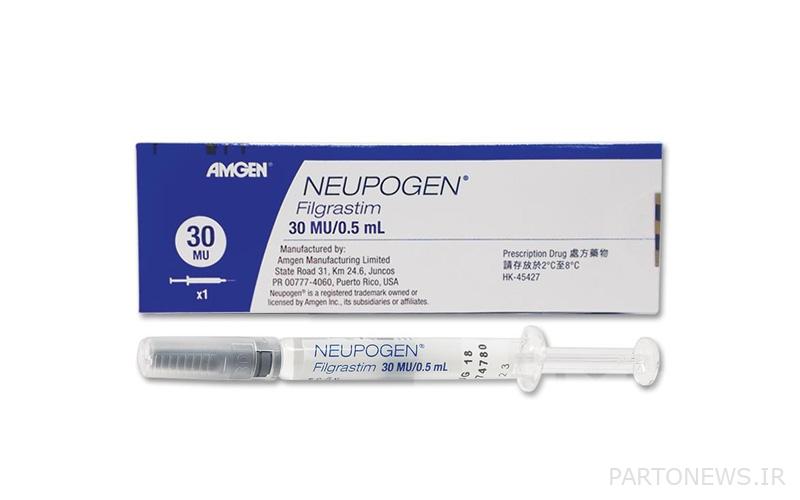Filgrastim (Filgrastim) and its uses and side effects

In today’s world of medicine and health, the search for new methods and technologies that help health and cure diseases has expanded greatly. Filgrastim is one of the medicinal substances that has attracted the attention of doctors and researchers in recent years and has an important place in the treatment of many neurological problems. Filgrastim ampoule, as one of the methods of providing this important and effective drug in combination with medical science and technology, has provided a new recovery and treatment for patients. In the continuation of this article, we will examine more closely the effects and applications of this product in various diseases and chemotherapy.
What we read in this article
Pharmaceutical forms of filgrastim
According to the needs of patients and doctors, pharmaceutical companies produce drugs in various pharmaceutical forms and standards. In this regard, many chemical and herbal medicines are produced in different forms, such as regular tablets, chewable tablets, injection solutions, capsules, syrups, etc. The dosage forms of filgrastim are 300 mcg/ml and 480 mcg/1.6 ml solution for injection, 300 mcg/0.5 ml and 480 mcg/0.8 ml solution with pre-filled syringe for SC. Based on the patient’s need for medicine and the desired dose, the doctor chooses different forms of this medicine.
- The biggest changes that will happen in WhatsApp this yearFebruary 3, 2024
- Applications for locating family and friends on AndroidFebruary 2, 2024
Uses of filgrastim ampoule
Filgrastim is a synthetic version of a certain natural substance that is made by your body. This medicine is used to help your body make more white blood cells. White blood cells are important to help fight infections. This product is given to people whose ability to make white blood cells is reduced (for example, due to chemotherapy, chronic neutropenia, or exposure to large amounts of radiation). It is also used in some treatment methods (such as bone marrow transplant or stem cells).
Uses of filgrastim ampoule in adults
- Myelosuppressive chemotherapy
- Induction or consolidation chemotherapy
- Collection of peripheral blood progenitor cells
- bone marrow transplant
- Severe chronic neutropenia
- Acute radiation syndrome
Uses of filgrastim ampoule in children
- Collection and treatment of autologous peripheral blood progenitor cells
- Cancer patients undergoing bone marrow transplantation
- Neutropenia
Pharmacological effects and mechanism of action of filgrastim drug
Mechanism of action of recombinant human G-CSF filgrastim; It acts on hematopoietic cells to stimulate the production, maturation and activation of neutrophils and increases the migration and cytotoxicity of neutrophils. 100% drug absorption and systemic metabolism is destroyed.
Dosage of filgrastim
Read the Patient Information Leaflet and Instructions for Use before you start using filgrastim and each time you get a refill. Depending on the type of product, this drug is injected once a day under the skin or into a vein. Dosage and duration of treatment are based on medical condition, weight, tests and response to treatment. If you are using this medicine at home, learn all preparation and use instructions from your healthcare professional and the product package. Remove the medicine from the refrigerator at least 30 minutes before the injection to allow it to reach room temperature.
Review of filgrastim usage in adults
- Myelosuppressive chemotherapy: To reduce the incidence of infection, as indicated by febrile neutropenia in patients with non-myeloid malignancies receiving myelosuppressive anticancer drugs with a significant incidence of severe febrile neutropenia.
- Induction or stabilization chemotherapy: This product is recommended to reduce the recovery time of neutrophils and the duration of fever, after induction or stabilization chemotherapy of patients with acute myeloid leukemia. The recommended dose is 5 mcg/kg initially, which may be increased by 5 mcg/kg for each course of chemotherapy depending on the duration and severity of ANC.
- Bone marrow transplantation: Recommended to reduce the duration of neutropenia and clinical consequences associated with neutropenia (eg, febrile neutropenia) in patients with non-myeloid malignancies undergoing myeloablative chemotherapy followed by bone marrow transplantation (BMT). The recommended dose is 10 mcg/kg over 24-4 hours (do not exceed 24-hour infusion).
- Severe chronic neutropenia: Recommended for long-term administration to reduce the incidence and duration of neutropenic sequelae (eg, fever, infection, oropharyngeal ulcers) in symptomatic patients with severe chronic neutropenia (SCN), including congenital neutropenia, cyclic neutropenia, or idiopathic neutropenia. will be
- Collection of peripheral blood progenitor cells: Indicated for mobilization of autologous peripheral blood progenitor cells (PBPCs) in peripheral blood for collection by leukopheresis. Start at least 4 days before the first loukapher and continue until the last day of loukapher.
- Acute radiation syndrome: Also used to prolong survival in patients acutely exposed to myelopoietic-suppressive doses of radiation (acute radiation syndrome hematopoietic syndrome). 10 μg/kg SC as a daily injection is recommended for patients exposed to myelosuppressive doses.
Filgrastim injection time
If you inject this medicine under the skin, first clean the injection site with alcohol. Change the injection site each time to reduce damage under the skin. Avoid injecting filgrastim into skin that is bruised, sensitive, red, hard, or has scars or cracks. If you are receiving chemotherapy for cancer, you should not use this medicine within 24 hours before or 24 hours after chemotherapy. Consult your doctor about when to use this medicine.
Precautions
This medicine may contain inactive ingredients (such as dry natural rubber or latex in the needle coating on the pre-filled syringe), which can cause allergic reactions or other problems. If you have medical records such as kidney disease, sickle cell disease, spleen problems, radiation therapy, specific addiction, hypersensitivity, etc., take the medicine with caution and as directed by your doctor. This medicine may cause dizziness and drowsiness in patients, avoid doing things like driving that require alertness.
- Allergic reactions (angioneurotic edema, allergic dermatitis, hypersensitivity, skin rash, itchy rash and urticaria) have been reported in some patients. Allergic reactions can recur within days of stopping the initial antiallergic treatment.
- Rare cases of ARDS have been reported. Consider evaluating patients with fever and lung infiltrates or respiratory distress for ARDS. Discontinue therapy in patients with ARDS.
- Severe and sometimes fatal sickle cell crisis can occur in patients with sickle cell disorders. Discontinue therapy if sickle cell crisis occurs.
- Increased bone marrow hematopoietic activity in response to growth factor treatment is associated with transient positive bone imaging changes. This should be taken into account when interpreting bone imaging results.
- Off-label use of PBPC mobilization has resulted in alveolar hemorrhage, resulting in pulmonary infiltrates and hemoptysis.
- In cancer patients receiving the drug as an adjunct to myelosuppressive chemotherapy, to avoid the possible risks of excessive leukocytosis, it is recommended to treat ANC after the rare occurrence of chemotherapy-induced ANC if ANC exceeds 10,000/mm³. be cut off
- During the course of prescribing therapy for PBPC mobilization in cancer patients, if the leukocyte count increases to more than 10,000/mm³, discontinue therapy.
- Simultaneous use with chemotherapy and radiation therapy is not recommended.
- Increased bone marrow hematopoietic activity in response to growth factor treatment is associated with transient positive bone imaging changes.
Contraindications for filgrastim
- Allergy to this drug or other ingredients in it
- Pregnancy or intention to become pregnant
- History of serious allergic reactions to filgrastim or pegfilgrastim products
- breastfeeding
- Blood problems (sickle cell disease)
- kidney disease
- Spleen problems
Side effects of filgrastim ampoule (filgrastim)
Dizziness, headache and pain or pain in bones, joints and muscles are some of the side effects of filgrastim ampoule. Redness, swelling, itching or bruising at the injection site may also occur. If any of these effects persist or worsen, tell your doctor or pharmacist right away. Some of the serious side effects of this drug include easy bleeding or bruising, pink or bloody urine, vomiting blood, coughing up blood, fast heartbeat, fever, purple, red spots on the skin, back pain, breathing problems, unusual decrease in urine, unusual fatigue, etc. is.
- Nausea and vomiting
- Skeletal pain
- alopecia
- Diarrhea, fever, fatigue, headache and anorexia
- Chest pain, cough and shortness of breath
- constipation
- stomatitis
- Sore throat
- urticaria

Drug interaction of filgrastim
Patients, before visiting the doctor, prepare a list of chemical and herbal medicines you use and show them to him. Drug interactions may change how your medications work or increase your risk of serious side effects. Do not use pegfilgrastim product while using filgrastim. This drug may interfere with some lab tests (such as bone imaging tests) and possibly cause false test results. Consult the laboratory personnel regarding the use of this drug.
Use of filgrastim (filgrastim) during pregnancy and breastfeeding
Available data from published studies, including several observational studies of pregnancy outcomes in women exposed to filgrastim products, have not shown an association with use during pregnancy and major birth defects, miscarriage, or adverse maternal or fetal outcomes. Reports in the scientific literature have described the passage of the drug through the placenta in pregnant women when administered less than or equal to 30 hours before preterm delivery (less than or equal to 30 weeks of gestation).
The effect of filgrastim ampoule on breastfeeding
There are published articles documenting the transfer of filgrastim into human milk. There are also reports describing the use of this drug in nursing mothers without side effects in infants. There is no information on the effects of this product on milk production. Other drug products are poorly excreted in breast milk, and Filgrastim products are not absorbed orally by infants.
Filgrastim storage conditions
Filgrastim injection solution or ampoule should be kept in a refrigerator and in a cool place. Keep all chemical and herbal medicines out of the reach of children and animals. Dispose of this product properly when it has expired or is no longer needed. Avoid pouring all kinds of medicines into the toilet well, street and sewer.
The last word about Filgrastim ampoule
According to scientific research and recent developments in this field, we can confidently say that filgrastim and the ampoule of this drug as a powerful and effective medical combination in the treatment of myelosuppressive chemotherapy, induction or stabilization chemotherapy, progenitor cell collection Peripheral blood, bone marrow transplantation, severe chronic neutropenia, acute radiation syndrome, etc. are used. Although this drug has many benefits and applications, as described in this article from the online pharmacy magazine Positive Green, it is only prescribed by doctors.
Site source: Medscape
I was born in 1370. I started content production in 2013 and the more time passes, the more I fall in love with my job.

